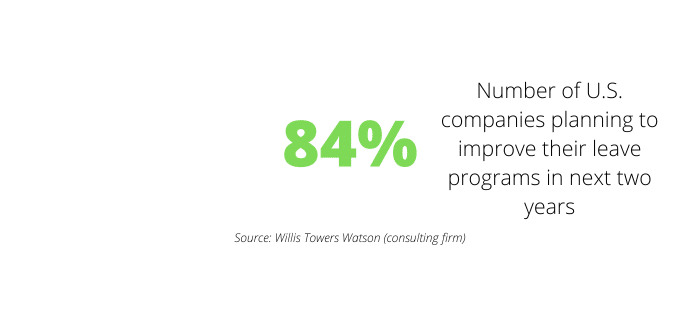The reason people work for a company is so that they can have a better life.
Once you see it framed that way, it’s hard to think about employees through any other spectrum. Combine that with the fact that employee retention is a crucial element to long-term efficiency, and it shines a light on the importance of employee benefits. Hiring skilled employees can be an expensive and time-consuming process, and if someone is a great culture fit, then replacing them is a tall task.
It has become popular for a company to say that it wants its employees to feel like they are part of a family at work, but perhaps it is even more important for a company to show its employees that it recognizes the way each of them prioritizes their own families.
One of the best opportunities to express this is when an employee welcomes a new child to their family –a time when one’s career, even to the most passionate workers, can feel small by comparison.
“We understand the importance of family time and support those who are experiencing major life events, such as having a child,” says Marissa Jansen, director of brand identity at Proforma, PPAI 100’s No. 3 distributor. “Our parental leave benefits are a way of encouraging our team members to enjoy these life experiences and feel supported by their work family.”

Marissa Jansen
Director of Brand Identity, Proforma
For some, like Proforma, a family-owned business that has grown into a $662 million distributorship network, parental benefits are a way to walk the talk of their stated values. As National Parents Day approaches on July 27, PPAI Media spoke to promo firms of different sizes to discuss what kind of parental benefits they offer, why and what type of preparation is needed to accommodate these precious moments.
What Can Expecting Parents Expect? / What Do Companies Offer?
Employees across industries face a number of different possibilities when it comes to workplace benefits involving childbirth.
- On a federal level, many U.S. employees are eligible for the Family and Medical Leave Act when they welcome a new child to their family. This exercises an unpaid leave for up to 12 weeks, but it protects the employee from termination as they care for and bond with their newborn.
- Additionally, 16 states offer some form of leave that is either subsidized by the government or requires employers to pay for the time.
Any company operating outside of those states can choose to create its own benefit structure surrounding parental leave (a company within those 16 states can add benefits on top of state policies, of course).
- One route that employers take with employees who give birth is short-term disability, which some states will demand in the case of pregnancy, and in other states, employers might choose to offer it as a benefit.
- In this scenario, which often requires a routine sign-off from a doctor, the exact duration of leave and amount of salary paid may vary depending on the plan. Some will pay a percentage of salary for an extended number of weeks. Others may pay the salary in full.
This is how Brand Fuel, PPAI 100’s No. 29 distributor, handles maternity leave: six weeks (or eight weeks if the employee undergoes a C-section) of paid leave covered through short-term disability.

Allison McLain, MAS
General Manager, Brand Fuel
While these are not legal requirements for Brand Fuel to offer, Allison McLain, MAS, the company’s general manager, says, “It’s a mix of supporting our talented, loyal staff through well-being and health initiatives, promoting equity and inclusion, employee retention, productivity and morale, legal compliance – ultimately, it’s just the right thing to do.”
Proforma opts to offer six weeks of paid maternity leave paid at 100% of the employee’s pay rate or salary. In addition to those six weeks, employees are able to enroll in short-term disability, which would provide an additional leave of six to eight weeks paid at 60% of their pay rate or salary.
“Family is at the core of our business,” Jansen says. “At Proforma, we value both our personal and professional families, as well as the relationships within our entire network, and the well-being of each of our team members.”
- In just the past year, Proforma has seen nine employees take parental leave, and 100% have returned to work after their time away. (They also received gift boxes with baby clothes and toys, only some of which were branded promo).
Gold Bond, PPAI 100’s No. 32 supplier, and another firm not located in a state that requires parental benefits, offers mothers four weeks of paid leave for recovery and bonding.
“At Gold Bond, we understand that welcoming a new child into a family is a major life event that deserves time, support and security,” says Inna Nasledova, Gold Bond’s director of marketing.

Inna Nasledova
Director of Marketing, Gold Bond
Business service provider OrderMyGear, based in Texas, which does not require employers to offer parental benefits, separates its leave policy into two categories, both of which can be taken: four weeks of fully paid medical leave for birthing parents recovering from pregnancy or childbirth and four weeks of fully paid bonding leave for all parents.
“One of the core tenants of the OMG Magic (e.g., our company culture and values) is to invest in each other and we view parental leave as an important way to invest in our team,” says from Charis Downey, director of people and talent at OrderMyGear. “Family is first. Welcoming a child is one of life’s most significant milestones, and we want OMG’ers to feel supported through it.”

Charis Downey
Director of People and Talent, OrderMyGear
Paternity Leave Creates Equity For Mothers
More and more companies are understanding that offering some kind of leave offered to fathers (or non-birthing parents) helps chip away at the unrealistic expectations put upon women in society. Beyond allowing fathers time with their newborn children and creating that bond early in the child’s life, by granting these policies companies can counter the default position that childcare is the responsibility of the woman in the relationship.
“Offering paid paternity leave has a profound impact on gender equality, both inside and outside the home,” says a study by the National Library of Medicine. “Taking leave can draw fathers into the daily realities of parenting, enabling development of a fuller understanding of parenting that supports self‐directed paternal involvement rather than reliance on a gendered division in which the mother manages and the father ‘helps.’
“Further, paid paternity leave gives women more opportunity to re‐enter the workforce, which can lessen the ‘motherhood penalty’ and its impact on women’s economic and promotion opportunities.”
- Brand Fuel offers five days of PTO for the non-birthing parent.
- Proforma offers two weeks of paid paternity leave.
- Gold Star offers one week of paid bonding leave for non-birthing parents.
- OMG’s four weeks of fully paid bonding leave includes spouses, partners, adoptive and foster parents.
While on the topic of equity, McLain pointed out that under the Fair Labor Standards Act, it’s required that an employer accommodate a recent mother with a lactation room. This is the type of accommodation that can also work in synergy with paternity leave; allowing a father the opportunity to care for the child and allow for the mother to work under reasonable conditions.
Equity and compassion are qualities that employees recognize at this immense moment of transition and vulnerability in their lives. Priorities are often adjusted, and while they want to their child to feel safe, they want to feel safe in their own conditions. One Gold Bond employee made testimony to the fact that a policy in place was crucial to this part of their time with the company.
Gold Bond Employee
“Knowing I could take time to be with my newborn without worrying about my job made me feel truly valued,” the Gold Bond employee said. “It’s one of the reasons I’m proud to work here. The transition into motherhood was overwhelming in so many ways, but having the space and support from Gold Bond allowed me to focus on bonding with my baby, recovering physically and adjusting emotionally without added stress made me even more committed to the company.”
These dynamics are showing in the competition for top talent. According to a survey conducted by the consulting firm Willis Towers Watson, 84% of U.S. employers plan to make changes to their leave programs within the next two years in order to improve retention.

Canada’s Policies Are More Generous
North of the U.S., in Canada, there is typically less variance in the leave that employees take after welcoming new children. From company to company, it is similar because these policies are regulated by the country’s government. To be clear, this is true of many countries when it comes to parental leave policies.
“The U.S. is the only developed nation that doesn’t have these type of required federally paid leave time of programs,” says Alex Henry, group benefits leader at Willis Towers Watson.
- In Canada, the birthing parent can take 15 weeks of maternity leave, and both parents can share 40 additional weeks of parental leave.
- These benefits pay them 55% of their income with a maximum weekly amount of $695.
- There is also the potential for extended parental benefits that reach up to 69 weeks at 33% of salary and a maximum of $417 per week.
PPAI Media reached out to Denise Taschereau, chair of PPAI’s Board of Directors and CEO of Canadian-based supplier Fairware, whose employees benefit from these government practices. She says that even under these conditions, there is a greater social safety net needed for parents to be able to work with a sense of security.
“What we continue to advocate for is access to affordable childcare,” Taschereau says. “There is a dire lack of spaces in many communities, and when parents do find a spot, the costs can be so high that it often discourages them from returning to work.

Denise Taschereau
CEO, Fairware & Chair, PPAI Board of Directors
“Solving this is essential to creating equitable and inclusive workplaces.”
Preparing For Your Employee’s Leave
It’s a bit of a Catch-22. Your employee is valuable, and so you want to give them the space they need during their big life moment. But that value will make their absence felt. There are different approaches to preparing for parental leave.
- At Proforma, respective departments are prepared to ensure they are equipped to handle the business flow as usual.
“In some cases, we are able to distribute certain responsibilities among other members, and in other cases, we hire temporary help to bridge any gaps,” Jansen says. “Regardless, our managers are well-informed in advance and able to plan accordingly for these types of leaves.”
- For Brand Fuel, team culture plays a part in bridging the gap of a valued member’s absence, but steps are still taken, especially because it is something that everyone can know about ahead of time.
“We have created processes to ensure nothing falls through the cracks that would degrade service levels and so that no one team member feels overburdened,” McLain says. “This also helps reassure the employee on leave that their work is in good hands.
“Having a solid back up process and team in place with pre-baby planning makes all of the difference.”
- OrderMyGear makes the argument that preparation for these sorts of moments, like anything, come down to the type of people you have on your staff and whether they can see their colleagues as teammates.
“We work closely with leaders to plan ahead and ensure coverage, but what truly makes this benefit work is the team itself,” Downey says. “It’s a collaborative effort where OMG’ers naturally step in to manage responsibilities and support one another, making transitions during parental leave feel seamless and reinforcing the strong sense of teamwork that defines our culture”
- Similarly, At Gold Bond, the parental leave program itself is a sign of trust and togetherness, and that is reflected in how business operates while a teammate is taking leave.
“While we do have some processes in place to ensure smooth transitions during parental leave, such as cross-training, temporary role coverage and early planning, we’ve also found that many departments adapt naturally,” says Nasledova. “There’s a strong community spirit here; people step up, collaborate and support one another.
“That culture makes all the difference and helps parental leave go from a potential disruption to a shared opportunity for growth and teamwork.”


